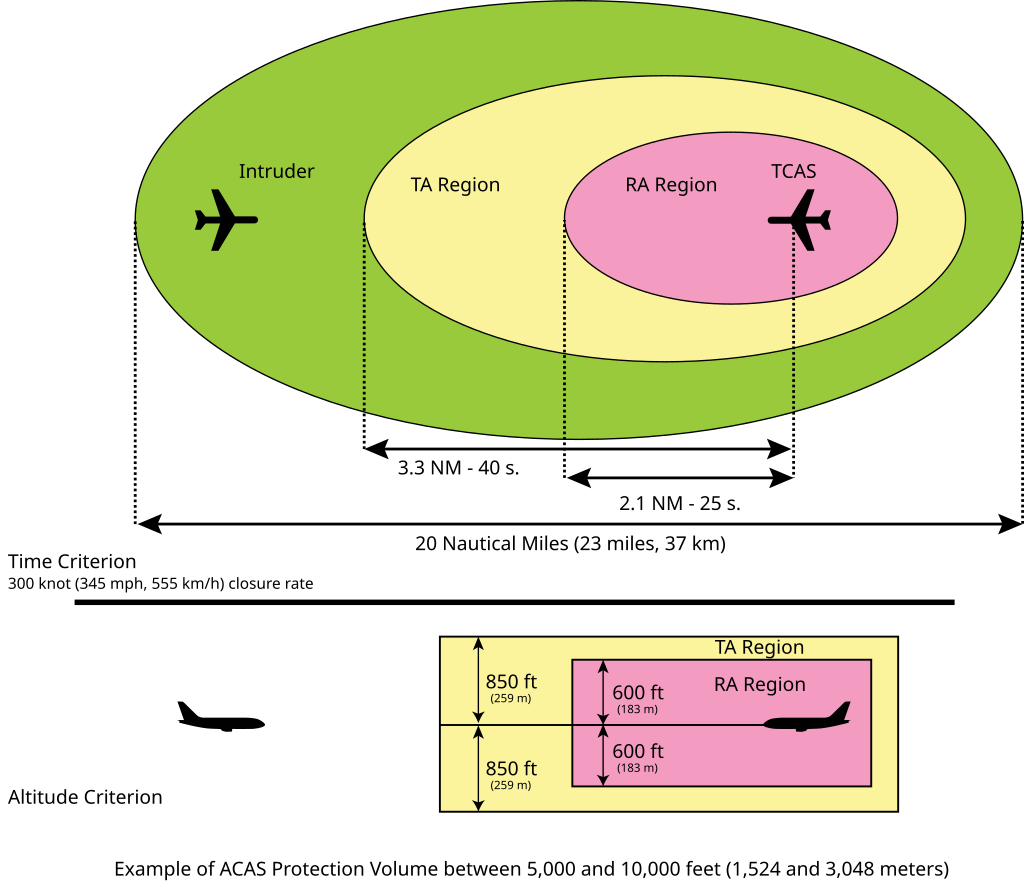TCAS or Traffic Alert and Collision Avoidance System
TCAS or Traffic Alert and Collision Avoidance System
ATCRBS as collision Avoidance System
Research on the area of mid air collision avoidance was on peak in 1950s and after the 1956 Grand Canyon mid air collision, impetus was seen on airline industries. At that time, traffic collision avoidance was relied on the ATCRBS or air traffic control radar beacon system. The ATCRBS is a system that is used in ATC to enhance surveillance radar monitoring and separation of air traffic. It consists of a rotating ground antenna and transponders in aircraft. The ground antenna sweeps a narrow vertical beam of microwaves around the airspace. When the beam strikes an aircraft, the transponder transmits a return signal back giving information such as altitude and the Squawk Code, a four digit code assigned to each aircraft that enters a region.
Introduction of TCAS
Till 1970s, the research was centered on this ATCRBS; airline industries were continuously improving the system. However in 1981 Federal Aviation Administration mandated all airlines to implement a concept called TCAS or Traffic Alert and Collision Avoidance System. At that time TCAS was equipped under VMC or Visual Metrological Conditions as it was not certified at that time. In aviation, VMC is an aviation flight category in which visual flight rules (VFR) flight is permitted that is, conditions in which pilots have sufficient visibility to fly the aircraft maintaining visual separation from terrain and other aircraft.
The Components of TCAS (Traffic Alert & Collision Avoidance System)
A TCAS installation on an aircraft consists
of the following component:
1. TCAS computer unit
The function of computer unit is to perform:
- Airspace surveillance.
- Intruder tracking.
- Its own aircraft altitude tracking.,
- Threat detection.,
- Resolution advisory (RA) maneuver determination.,
- Selection and generation of advisories.
The TCAS Processor uses pressure altitude, radar altitude, and discrete aircraft status inputs from its own aircraft to control the collision avoidance logic parameters that determine the protection volume around the TCAS aircraft.
2. Antennas
The antennas used by TCAS include a directional antenna that is mounted on the top of the aircraft and either an omni-directional or a directional antenna mounted on the bottom of the aircraft. Most installations use the optional directional antenna on the bottom of the aircraft. In addition to the two TCAS antennas, two antennas are also required for the Mode S transponder. One antenna is mounted on the top of the aircraft while the other is mounted on the bottom. These antennas enable the Mode S transponder to receive interrogations at 1030 MHz and reply to the received interrogations at 1090 MHz.
3. Cockpit presentation
The TCAS interface with the pilots is provided by two displays: the traffic display and the RA display. These two displays can be implemented in a number of ways including displays that incorporate both displays into a single, physical unit. Regardless of the implementation, the information displayed is identical.

How
TCAS Works?
TCAS involves communication between all aircraft that are equipped with an appropriate transponder provided the transponder is enabled and set up properly. Each TCAS equipped aircraft interrogates all other aircraft in a determined range about their position via the 1030 MHz radio frequency, and all other aircraft reply to other interrogations via 1090 MHz. This interrogation-and-response cycle may occur several times per second. Based on this data, the TCAS system builds a three dimensional map of aircraft in the airspace, incorporating their range garnered from the interrogation and response round trip time, altitude as reported by the interrogated aircraft, and bearing (by the directional antenna from the response). Then, by extrapolating current range and altitude difference to anticipated future values, it determines if a potential collision threat exists.
The next step beyond identifying potential collisions is automatically negotiating a mutual avoidance maneuver; currently, maneuvers are restricted to changes in altitude and modification of climb/sink rates between the two or more conflicting aircraft. These avoidance maneuvers are communicated to the flight crew by a cockpit display and by synthesized voice instructions.

Follow us @ Facebook : Advanced Tech World
Follow us @ Twitter : Advanced Tech World
Ask us @ Quora : Advanced Tech World
Check Out Latest Videos @ YouTube
What happened to Concorde?



